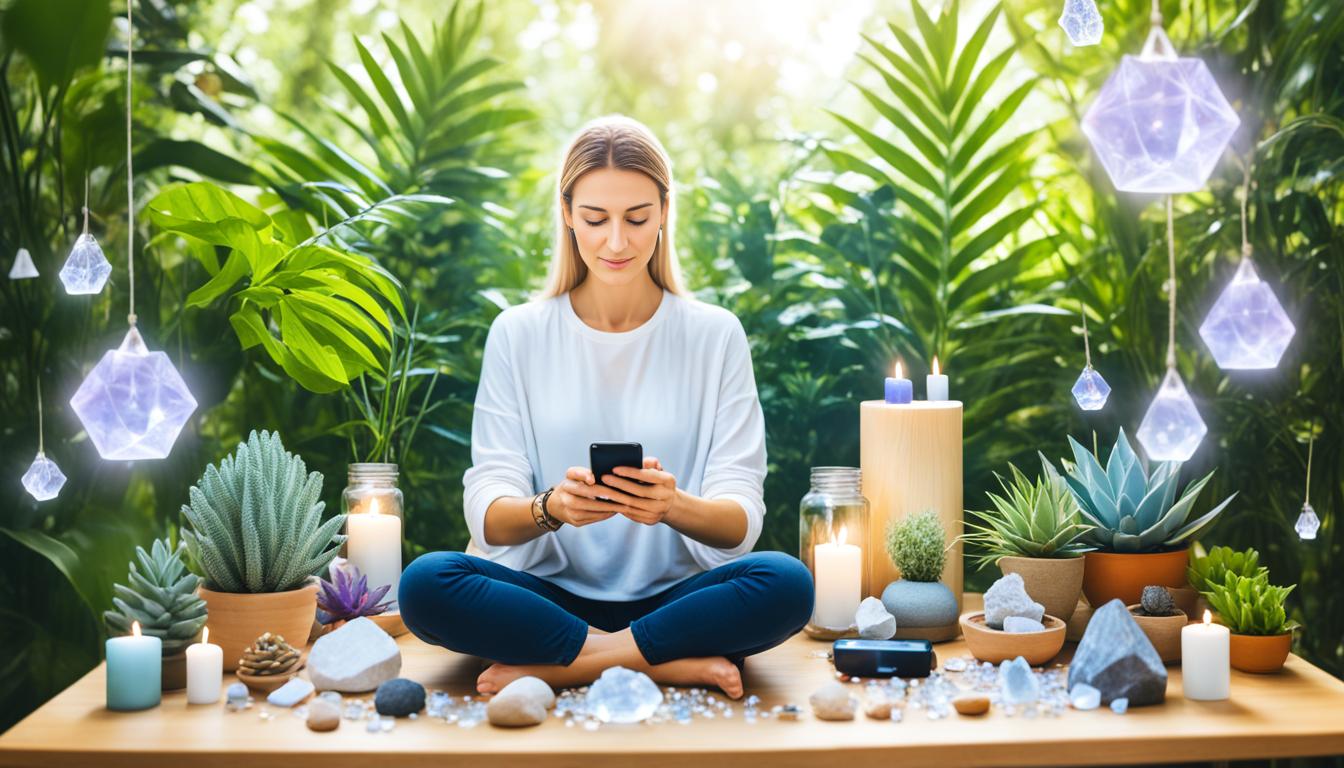In today’s world, where constant notifications and endless timelines overwhelm us, the need for a Social Media Detox is clear. Many have taken a break from platforms like Facebook, Instagram, and Twitter for nearly 500 days. They’ve found that stepping away is crucial for mental clarity and rejuvenation. Taking a break from social media is not just an escape; it’s a vital mental health break. It helps you focus, find peace, and live life beyond the screen.
Starting your digital detox means acknowledging the mental strain of constant social media use. You’ll see the profound peace that comes from unplugging. This break not only offers relief from information overload but also helps you live more mindfully. Many have seen a decrease in anxiety, improved mood, and stronger connections with family and friends. The benefits are vast when you start this journey of self-care.
Key Takeaways
- A Social Media Detox can significantly improve mental clarity and well-being.
- Unplugging helps reduce information anxiety and scattered attention.
- Breaking free from social media fosters deeper real-life connections.
- A digital detox encourages a mindful approach to technology use.
- Engaging in offline activities can lead to enhanced creativity and focus.
- Taking periodic breaks from social media can renew your lifestyle and outlook.
Understanding the Need for a Social Media Detox
The digital era has changed how we interact with the world, but it comes with a price. Social media addiction is a growing concern, affecting mental health significantly. On average, a U.S. adult spends about 11 hours daily on media, which can harm well-being. If you feel overwhelmed, you’re not alone. A Common Sense Media poll found 50% of teens feel addicted to their devices, and 41% experience anxiety when they can’t check their accounts. This shows the importance of knowing when it’s time for a detox.
Impact of Social Media on Mental Health
Excessive use of technology and social media can deeply impact mental health. Research indicates that 73% of people feel stressed from the constant information overload. Moreover, technology use often disrupts work-life balance, leading to more stress. It’s reported that 18% of U.S. adults see technology as a major stress source, causing more depression and anxiety. Cutting down social media use to about 30 minutes daily can help improve mental health, reducing loneliness and boosting overall well-being.
The Rise of Social Media Addiction
The fear of missing out (FOMO) drives compulsive social media behaviors, making addiction more likely. A significant 67% of young adults experience FOMO when using these platforms. The link between too much social media and mental health issues highlights the need for a detox. Taking a break can lead to new habits that support digital wellness, with many reporting better sleep and less anxiety.
Recognizing the Signs of Social Media Overuse
Social media has changed how we connect, but it can also lead to unhealthy habits. It’s crucial to recognize overuse signs for a balanced tech relationship. FOMO (Fear of Missing Out) and JOMO (Joy of Missing Out) are key concepts in this area. Knowing the difference between them is vital for managing screen time effectively.
FOMO vs. JOMO
FOMO is the anxiety that others are having fun while you’re not. This fear makes you stay constantly connected, leading to too much screen time. JOMO, however, is about valuing your current experiences and connections. Switching to JOMO can improve your mental health and support a healthier digital lifestyle.
Physical Symptoms Linked to Screen Time Management
Too much social media use shows up in physical symptoms like poor sleep and chronic fatigue. Using social media for more than four hours a day is a red flag, leading to anxiety, irritability, or even depression. The algorithms aim to keep you hooked, creating a cycle of dependency. Noticing these physical signs can help you find a better digital balance.

The Benefits of a Digital Detox
Starting a digital detox can significantly alter your life. It creates space for reflection and offers numerous benefits for your mental and physical health. By reducing stress, it can transform your daily routines and improve your overall quality of life.
Reducing Stress and Anxiety Levels
One of the key benefits of a digital detox is the notable decrease in stress and anxiety. By stepping away from constant notifications and endless scrolling, you regain control over how you respond to daily challenges. This break from digital overload leads to mental clarity, providing a much-needed sense of peace.
Improving Sleep Quality
Reducing screen time, especially before bed, improves sleep quality. The blue light from devices disrupts your natural sleep cycle, causing restless nights. By spending time each evening without screens, you encourage more restorative sleep, helping you achieve that well-deserved rest.
Enhancing Productivity and Focus
A digital detox boosts productivity and focus by reducing distractions. With fewer things competing for your attention, you can delve deeper into your tasks. Many report sharper concentration and increased output, allowing you to fully immerse yourself in hobbies or projects. This not only benefits your mental health but also enriches your daily experiences.
For more insights on implementing a successful digital detox, check out this resource.

Steps to Begin Your Social Media Detox
Starting a social media detox might seem daunting, but it’s achievable with the right steps. Begin by setting boundaries around how you use technology. This approach helps you take back control over your time and focus.
Setting Clear Boundaries with Technology
Allocate specific times in your day for technology use. Utilize tools like Screen Time or Moment to monitor your usage and spot patterns that lead to over-engagement. Turning off notifications can significantly reduce distractions from platforms like Facebook and Instagram. As you follow these social media detox steps, consider setting a phone bedtime. This simple change can help curb late-night scrolling and enhance sleep quality.
Identifying Triggers for Social Media Use
Understanding what triggers your social media use is key to detox success. Analyze your phone habits and discuss them with friends or family. Support from others can help maintain accountability and aid in adjusting your routines. Using physical reminders, like a rubber band on your phone, can prompt you to pause before scrolling aimlessly. These deliberate actions will improve your awareness of why you check social media, enabling you to focus on more fulfilling activities.
Creating a Tech-Free Environment
Adopting a tech-free environment leads to a calmer, more fulfilling life. It sets the stage for personal growth and rejuvenation, free from digital distractions. Begin by setting aside areas like a reading nook or a meditation corner, where screens are forbidden. This approach creates a peaceful space ideal for relaxation and mindfulness.
Transforming Your Personal Space
Revamp your living space to minimize digital distractions. Add elements like plants, cozy seating, and soft lighting to craft a serene haven. These changes not only beautify your space but also encourage participation in activities away from screens. Picture yourself enjoying a book or doing yoga in a peaceful setting, far from technology, inviting tranquility.
Engaging in Offline Activities
Explore various offline activities that nurture your creativity and foster connections. Try hobbies such as painting, gardening, or playing a musical instrument. These activities are rewarding, replacing time usually spent on social media. They refresh your mind and offer chances to bond with loved ones deeply.

Implementing a Gradual Reduction in Screen Time
Transitioning to a lifestyle with less screen time demands careful planning and execution. Reducing screen time can greatly enhance your well-being and boost focus. Start by setting clear daily limits on social media use.
Setting Daily Limits on Social Media Usage
To cut down on screen time, define specific time slots for social media. Aim to reduce your daily screen time by two hours. Utilize apps that track your usage to monitor progress and enforce these limits. It’s crucial to set realistic goals, allowing for gradual changes rather than sudden ones.
Scheduling Tech-Free Times Throughout the Day
Integrating tech-free times into your daily schedule can lead to a more balanced digital life. Allocate specific times as screen-free, like during meals or before sleep. These tech-free periods encourage deeper connections and mindfulness. Activities such as hobbies, reading, or outdoor time offer enriching alternatives that make your life more fulfilling.

Finding Alternative Activities During Your Detox
Embarking on a social media detox opens up a world of opportunities for enriching your life. This period is ideal for discovering hobbies that can replace the time spent scrolling. Instead of constantly checking updates, channel your energy into meaningful activities.
Exploring Hobbies and Interests
Exploring hobbies can spark passion and creativity. Activities like cooking, gardening, or painting offer a therapeutic escape and engagement. Consider joining local workshops or classes to learn new skills with others. These experiences not only enhance your personal growth but also foster a sense of community. For more ideas on this journey, explore options available for finding hobbies that captivate your interest.
Prioritizing Quality Time with Loved Ones
Your social media detox is a perfect opportunity to strengthen bonds with family and friends. Dedicate time for activities together, like a game night or exploring nature. Face-to-face interactions enhance relationships and build deeper connections. Embracing these moments of quality time allows you to create memories that truly matter, away from digital distractions.

Staying Accountable and Tracking Your Progress
In your social media detox journey, accountability is key. Building support networks boosts motivation and keeps you on track with your goals. Connecting with others who share your goals offers the encouragement needed to overcome obstacles.
Joining Support Groups or Communities
Joining support groups or online communities focused on social media detox can greatly increase your commitment. Sharing your goals with others can enhance accountability by up to 40%. These groups provide a space to share experiences, advice, and success stories, fostering a sense of unity.
Tracking progress with peers ensures accountability, pushing you to meet your objectives. Regular interactions with these communities keep you motivated and supported, helping you stay on track.
Reflecting on Your Journey Regularly
Regular reflection is vital for monitoring your progress. Keeping a journal of your experiences helps track your journey. Recording both challenges and achievements highlights your growth over time.
Reflecting on your journey not only strengthens your commitment but also offers valuable insights. Assessing your usage patterns objectively can help adjust your goals, ensuring you remain accountable throughout your detox.
![]()
Embracing the Unplugged Lifestyle After Detox
Transitioning to an unplugged lifestyle after a digital detox can be transformative. You start to enjoy the joy of missing out (JOMO). This shift in mindset lets you appreciate the present and connect deeper with the world.
Embracing JOMO means choosing real-life experiences over virtual ones. This choice often leads to a sense of fulfillment that screen-addicts miss out on.
Discovering the Joy of Missing Out (JOMO)
Those who leave their devices behind often feel more satisfied. Studies show that teens who took a break from social media felt better about life and happier. This highlights how crucial an unplugged lifestyle is for mental health.
By focusing on what’s important, you can do activities that boost your well-being. This could be anything from nature walks to new hobbies. Such activities not only spark creativity but also strengthen bonds with family and friends.
Building Lasting Habits for Digital Wellbeing
To keep the detox benefits, consider making habits that support digital wellbeing. Device-free dinners can improve family communication. Switching screen time for reading can enhance sleep quality.
Adults who prefer offline activities sleep better and connect deeper with others. Cutting down on screen time also means more physical activity. This reduces neck strain and eye fatigue, showing why an unplugged lifestyle is key.
Practicing mindfulness and setting clear tech goals can help you manage your tech use. As you dive deeper into your unplugged life, think about what you value and how you want to interact with technology. Building these habits brings clarity and purpose to your digital life.

Conclusion
Reflecting on your social media detox journey reveals profound changes in your mental and emotional health. This experience brings clarity and peace by removing the constant stream of notifications and comparisons. It shows the benefits of stepping away from the digital world.
Many have found that a 30-day detox allows them to redirect their time to meaningful connections and offline activities. This shift highlights how social media can hinder happiness and increase stress. By focusing on simpler moments, individuals often experience higher life satisfaction and wellbeing.
It’s vital to maintain a healthy relationship with technology as you move forward. You might not need to cut out social media completely, but setting boundaries is key. This approach ensures you enjoy its benefits without the negative effects of anxiety or FOMO. By navigating the digital world thoughtfully, you can continue to grow and learn. Consider exploring more resources at goodemma.com to support your tech-free lifestyle.
FAQ
What is a Social Media Detox?
How can a digital detox improve my mental health?
What signs indicate that I might be overusing social media?
What steps should I take to start my Social Media Detox?
What alternative activities can I pursue instead of using social media?
How important is accountability during a Social Media Detox?
How can I maintain the benefits of my Social Media Detox after it’s over?
Source Links
- My 500 Days of Social Media Detox: A Journey to Mindful Living – https://medium.com/proud-as-pie/my-500-days-of-social-media-detox-a-journey-to-mindful-living-6869c3c1913e
- YogiAllie – Yoga + Wellness – https://www.yogiallie.com/health-wellness/what-a-social-media-detox-did-for-me
- Social Media Detox – What I Learned from No Social Media for 100 Days – Hello Brownlow – https://hellobrownlow.com/2022/11/11/social-media-detox/
- The Benefits of Doing a Digital Detox – https://www.verywellmind.com/why-and-how-to-do-a-digital-detox-4771321
- Social Media Detox – https://www.safe2helpil.com/depression/social-media-detox/
- 5 Reasons to Unplug From Social Media for Better Mental Health – https://www.cnet.com/health/mental/social-media-detox/
- Social Media Addiction Warning Signs | How To Tell If It’s Addiction – https://www.addictionhelp.com/social-media-addiction/warning-signs/
- Social Media Addiction – https://www.addictioncenter.com/behavioral-addictions/social-media-addiction/
- 4 Reasons to Do a Digital Detox – https://health.clevelandclinic.org/digital-detox
- What is a Digital Detox and Do You Need One? – https://www.lifespan.org/lifespan-living/what-digital-detox-and-do-you-need-one
- Characteristics of social media ‘detoxification’ in university students – https://www.ncbi.nlm.nih.gov/pmc/articles/PMC7717533/
- Addicted to Social Media? Here’s the Best Way to Detox – https://www.goodhousekeeping.com/life/g30681374/social-media-detox-tips/
- 10 tips for a social media detox – Pickard Properties – https://pickardproperties.co.uk/talking-points/10-tips-for-a-social-media-detox/
- How to Take a Social Media Detox: Top Ten Tips – https://www.integrativenutrition.com/blog/social-media-detox
- Social Media Detox Retreat – Plan To Disconnect | Orange Springs – https://orangespringsretreat.com/how-to-plan-a-tech-free-social-media-detox-retreat/
- Digital Detox: Creating A Tech-Free Lifestyle – https://medium.com/@thrivereads/digital-detox-creating-a-tech-free-lifestyle-ce78cbc0ef8a
- Digital Detox: How To Reclaim Control of Your Screen Time and Boost Happiness | Mindful Health Solutions – https://mindfulhealthsolutions.com/digital-detox-how-to-reclaim-control-of-your-screen-time-and-boost-happiness/
- Digital Detox: Reducing Screen Time for Mental Well-being – https://michiganhealthandwellness.com/digital-detox-reducing-screen-time-for-mental-well-being/
- What To Do Post-Social Media Detox: A Reintegration Guide – https://www.thegoodtrade.com/features/social-media-break-getting-back-on/
- Digital Detox: How to Break Free from Social Media Addiction and Reclaim Your Life – https://www.benjaminbonetti.com/blogs/articles-reviews/digital-detox-how-to-break-free-from-social-media-addiction-and-reclaim-your-life
- Your 2021 Social Media Detox Guide – https://ourfabriq.com/article/social-media-detox-2021
- 30-Day Digital Detox Challenge | Regis University – https://www.regis.edu/news/2023/regis-life/11/digital-detox-challenge
- How to do a social media detox | IGNITE – https://ignitestudentlife.com/how-to-do-a-social-media-detox/
- Daily Habits: Digital Detox: Unplugged: Embracing a Digital Detox as a Daily Habit – FasterCapital – https://fastercapital.com/content/Daily-Habits–Digital-Detox–Unplugged–Embracing-a-Digital-Detox-as-a-Daily-Habit.html
- Disconnect to Reconnect: The Power of a Digital Detox for Mental Wellness – https://medium.com/thrive-tribe-magazine/disconnect-to-reconnect-the-power-of-a-digital-detox-for-mental-wellness-766766c0c7fc
- Digital Detox: Unplug Living for a Day – https://www.linkedin.com/pulse/digital-detox-unplug-living-day-zoya-ashabi-pennf
- Taking a Break: The Effects of Partaking in a Two-Week Social Media Digital Detox on Problematic Smartphone and Social Media Use, and Other Health-Related Outcomes among Young Adults – https://www.ncbi.nlm.nih.gov/pmc/articles/PMC10740995/
- What I Learned From a 30-Day Social Media Detox – https://wanderingaimfully.com/social-media-detox-recap/
- Need a Break from Social Media? Here’s Why You Should — and How to Do It – Harvard Summer School – https://summer.harvard.edu/blog/need-a-break-from-social-media-heres-why-you-should-and-how-to-do-it/


